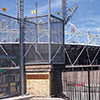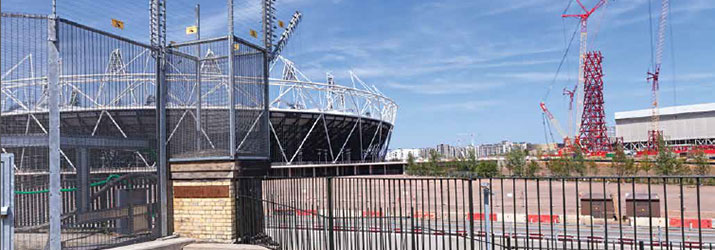
First Line of Defense
New technologies help meet the demand to ward off strangers
- By Joseph Goudlock
- Apr 01, 2013
 Perimeter security encompasses a plethora of physical security solutions
including, intrusion-detection systems, crash-resistant barriers,
access control, gate operators and high-security fencing. Integrated
security solutions have evolved to meet the demands of perimeter security,
leading to the development of new technologies. These range
from fence-mounted sensors, fiber optic, taut wire, microphonic cables, rattler-vibration
sensors; open-area sensors microwave, infrared, ground-based radar; and
buried sensors (fiber optic, leaky coaxial, geophone) and sound sensors that include
audio alarming and video sensors, which incorporate video analytics.
Perimeter security encompasses a plethora of physical security solutions
including, intrusion-detection systems, crash-resistant barriers,
access control, gate operators and high-security fencing. Integrated
security solutions have evolved to meet the demands of perimeter security,
leading to the development of new technologies. These range
from fence-mounted sensors, fiber optic, taut wire, microphonic cables, rattler-vibration
sensors; open-area sensors microwave, infrared, ground-based radar; and
buried sensors (fiber optic, leaky coaxial, geophone) and sound sensors that include
audio alarming and video sensors, which incorporate video analytics.
Integrated technologies represent baseline solutions for end users addressing perimeter
security needs. There are numerous things in the many facets of perimeter
security to consider that pertain to the current and projected market for this vertical.
Currently, North America and Europe have the highest expenditures for defense
and perimeter security applications. One of the factors supporting this growth is
the funding of the Chemical Facility Anti-Terrorism Standards (CFATS), which
established risk-based performance standards for chemical facilities. These standards
created opportunity for 6,000 new sites that require perimeter security upgrades
to comply with CFATS standards. Additionally, government mandates are
a major driver of market growth for perimeter security. The most unique facet
of the perimeter security industry also is one of the biggest drivers of the sector’s
market growth. Outside of government-based applications, many perimeter
security projects must conform to government security guidelines across vertical
sectors, such as CFATS.
Thus, local-level guidelines are created for risk-related assessments in individual
sectors, a huge benefit to commercial infrastructures applicable for perimeter
security. Contrarily, a lack of government oversight and enforcement can prove
these mandates unsuccessful and result in a decrease of project-based work for
perimeter security investments.
Government mandates and security standards require corporate investment in
perimeter security, but until these guidelines are coordinated between local and
national levels, market growth potential will remain unrealized.
Investments in perimeter security are manipulated by a multitude of external
market characteristics relative to global politics, including the threat of terrorism
and economic change. The high-security solutions offered by many perimeter
security manufacturers are most prevalent at high-risk government sites, such as
airports, military bases and prisons. Adapting to the risk factors of facilities that
are responsible for human life and intellectual and physical property, the size and
segmentation of the non-residential perimeter security market must frequently evolve. A significant factor influencing the applicability
of perimeter security technologies is government-
based infrastructure specifications. This market
characteristic naturally relates the prospect of government
action or inaction to a larger barrier for growth
in non-residential perimeter security markets than
other residential-specific security technologies. The
variability of the environments within these global
markets becomes a major consideration of perimeter
security manufacturers when researching and developing
technologies.
Because no two sites are the same topographically
and demographically, the specifier, engineer and manufacturer
must consider a wide variety of fence types,
environmental situations and interior breach vulnerabilities
to provide a complete security solution.
Considering the growing international markets for
perimeter security, high-risk facilities aren’t the only
filters applicable for site prospecting. Others include
sites containing government-regulated raw materials;
BRIIC economies in developing countries recognizing
a rise in GDP, factors that emulate a path towards
government regulated distribution or storage methods.
The perimeter security market is directly proportional
to GDP, as the decrease in market growth for
perimeter security during the 2009 global economic
decline revealed. However, increased government involvement
in perimeter security and an influx of new
government funding is expected to spur a Compound
Annual Growth Rate (CAGR) of 9 percent in global
markets by 2014. This Direct Foreign Investment
(DFI) equals a spike of nearly $200 million from the
markets’ estimated net worth of $371.2 million in
2009. Growth in global markets has created another
unique opportunity for business growth in the perimeter
security market and is suspected to continue to
increase over the next five years.
A distinguishing factor in the perimeter security
market is site uniqueness. New security solutions are
inspired by necessity, making project oversight of
potential site vulnerabilities a major focus. For example,
industrial sites experience a high volume of
pedestrian and vehicular traffic. These sites also are
frequently in non-residential areas, and remain unmanned
on weekends. To counteract these exposed
opportunities for unauthorized access, boom barriers
or sliding gates on a rail could be paired with video
content analysis (VCA) security cameras, and a 2-way
speaker/microphone to accurately identify entrants
and control access portals. A system designer also
should consult with a perimeter security professional
to address post-business-hour site breaches by specifying
integrated, unmanned security solutions.
A ground-based radar system around inventory
storages will detect movements around low-traffic, internal
areas both above- and below-ground level. Video
sensors in rooms containing intellectual and material
properties provide accurate review and analysis
of situations involving property loss. Sound-activated
alarm systems identify break-ins through noise analytics
and decibel strength, and activate other alarming
systems at the point of a break-in. Tech-based
integrations for perimeter security should focus on
the use of remote network monitoring (RMON), the
integration of a physically-activated security notification
that will alert a site’s security network monitor
of a breach, and doubles as a secondary alarm verification
to prompt law-enforcement response. This
creates a more accurate response system for security
system monitors who can use technologies, such as
speaker and microphones, to identify an intruder and
deter them from advancing through direct vocal contact,
rather than physical means.
The idea behind achieving effective perimeter security
is two-tiered: intrusion prevention and property
protection. Perimeter security is the first line of defense
in security solutions, but the technical innovations
behind it take it beyond the front lines of anyone’s
property borders. Innovations in technologies such as
sound-activated alarms and speaker microphones, create
a multitude of internal perimeters on a site, allowing
for intrusion detection beyond the front gates.
The effectiveness of perimeter security is dependent
on timely, credible alerts that allow enough
detail to respond to threats, or act internally as a
quick-response system. For example, sound-activated
alarming can activate IP video cameras in a breached
security zone, simultaneously acting as a secondary
verification to a break-in, as opposed to strictly relying
on video analytics that may not have a full visual
range of a breached area. The nature and location of
a perimeter intrusion is necessary to relaying a proper
response. The use of automated-detection technologies—
coax and fiber-fence sensors, open-area infrared
sensors, and buried geophone sensors—provide
a base level of perimeter detection. These integrated
technologies allow for perimeter security to be a
multi-tiered functionality on a site.
For example, buried geophone sensors convert
ground movement into voltage, and analyze the seismic
response measured by deviations from a seismic
baseline. Perimeter security applications use this technology
to inform a system operator when an intruder
enters a secure area. Accompanying this information
with photographic data allows a system operator to
review a breach in detail and analyze vulnerabilities
in a site’s security system. Critiques of this method
are easy to obtain, such as immediate differentiating
between a possible unwarranted intruder and an animal
running onto a site’s property. The necessities for
achieving effective perimeter security—timely, credible
alerts that allow for enough detail to respond—
have created a market for technologies that offer a
quick enough response time to deal with an intruder
in real time.
The fastest growing technology for advantageous
intrusion response is video analytics. Video sensors
and thermal cameras are used for detecting otherwise
“invisible” threats in a wide spectrum of light conditions,
making them applicable for large outdoor areas
as well as indoor monitoring. Video-content analytics
are capable of using motion detection and object detection
to determine the presence of a person or car.
Another approach is sound-activated monitoring.
Manufacturers in audio-monitoring technology have
structured products to tie into IP-network cameras,
activating a response zone in larger facilities to intrusion
alerts. This method of perimeter breach detection
benefits a security network monitor by acting as
a second-response system to alert authorities without
the need for physical confirmation of an intruder.
Additionally, a facility using staff-monitored,
multi-zone security systems benefit from the use of
audio detection when determining the exact location
of intrusion, a necessary factor in effectively responding
to a security breach.
Perimeter security equipment may see even more
advances in coming years. Facets of the security products
industry that will be affected by this growth also
include video- and audio-monitoring technologies
that allow for remote address to on-site perimeter
breaches. Most video-based integrations deal with
image content to detect a perimeter breach, whereas
audio-based integrations deal with sound-identifying
technologies to distinguish between sounds and activate
either an alarm-base station or a zonal, videomonitoring
system to the area of breach.
These first response opportunities highlight the first
line of defense in high-risk facilities’ security solutions:
Perimeter security as a singular security system encompasses
a myriad of physical security solutions, including
crash-resistant barriers, access control, gate operators
and high-security fencing. Tech-based solutions
have evolved to meet the demands of perimeter security,
leading to the development of new technologies.
While these baseline solutions provide a nonphysical
barrier and notification of perimeter breach
points, achieving effective perimeter
security must use integrated security
technologies.
This article originally appeared in the April 2013 issue of Security Today.